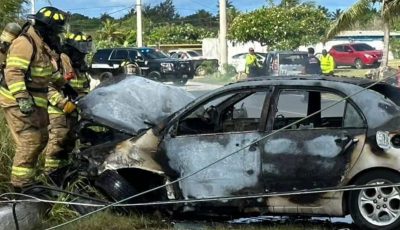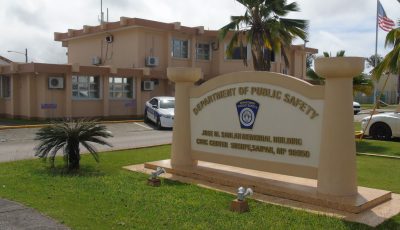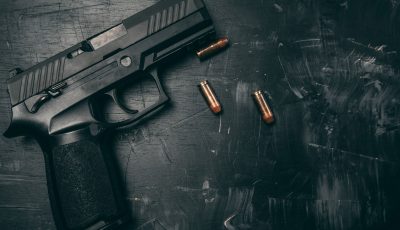‘Hair strand matches Romero sample’
FBI expert: Fibers in car consistent with fibers in leggings used to strangle victim
A hair strand found inside the car that Joseph A. Crisostomo allegedly drove on the day bartender Emerita Romero went missing on Feb. 5, 2012, matched the hair sample taken from Romero during autopsy, according to a Federal Bureau of Investigation expert yesterday.
Testifying for the CNMI government in the ongoing jury trial of 40-year-old Crisostomo, physical scientist/physical examiner Linda Otterstatter also disclosed that fibers found in the same car were consistent with black cotton fibers in the leggings that was found around Romero’s neck.
FBI special agent Haejun Park earlier testified that a black cloth wrapped around the victim’s neck was possibly used to strangle her.
Teacher Taj Van Buren, who was then Romero’s boyfriend, also took the witness stand yesterday and revealed that prior to Romero’s disappearance on Feb. 5, 2012, she texted him that she would ride a taxicab on her way to his house.
Otterstatter, who is a hair and fiber expert, gave a PowerPoint presentation about trace evidence, particularly how hair and fiber examinations are done as well as hair and fiber comparison processing techniques.
Otterstatter said the FBI Lab in Virginia received from the FBI Saipan office the hair that was recovered from the front passenger side of a Toyota Corolla with license plate ACG-246 on March 14, 2012. That same day, Otterstatter said, the FBI Lab also received Romero’s hair sample.
She said her analysis led her to conclude that the hair from the car matched Romero’s sample hair.
On the fiber analysis she made in June 2012, Otterstatter said she concluded that fibers taken from the driver’s side of the car were consistent with the fibers of the black cotton leggings taken from Romero. This means the fibers found from the car have the same fiber characteristics as the leggings, she added.
Otterstatter said that two black/brown polyester fibers taken from the right passenger seat of the car were also consistent with the fibers of Romero’s zorie found at the former La Fiesta Mall.
Responding to defense attorney Janet H. King’s questions, Otterstatter agreed with King that hair examination does not constitute personal identification. She also stated that fibers cannot be identified to a single source.
Otterstatter disclosed that she found hair of Caucasian characteristics from Romero’s zorie. She said she also found hair of Caucasian characteristics in Romero’s pantyliner.
She said Crisostomo’s hair sample was dissimilar to the hair taken from Romero’s zorie.
She also disclosed that her analysis of some of the hairs taken from Romero’s body and submitted for analysis indicated they were dog hairs.
Otterstatter said a black cotton fiber found in Romero’s fingernails on her left hand was not tested because the leggings was around the victim’s neck.
Van Buren, who was next on the witness stand, said he was then a frequent customer of Godfather’s Bar and that Romero was his girlfriend and that they had a sexual relationship. Van Buren said he and Romero last saw each other when she visited him at his house on Feb. 2, 2012.
He said on the evening of Feb. 4 to early morning of Feb. 5, 2012, he and Godfather’s owner Scott Dottino had a couple of beers at two establishments. He said he went home on a taxicab at 1am on Feb. 5.
Van Buren said that Romero then texted him that she would just ride a taxi on her way to his house. That was her last text message to him.
He said he started to worry when the taxi driver they know went to his house at 3am and told him that Romero called to pick her up, but she was not there.
“I tried to call her but her phone was dead,” Van Buren said, adding that he got worried so he called 911, texted her, and contacted some people.
Van Buren said that Romero was supposed to report for work at 5pm on Feb. 5, but she did not show up, and that got him really worried. He called the police and officers came and started investigating.
Van Buren said he also called FBI special agent Joseph Auther and informed him about what happened.
Van Buren said three or four days after Romero’s body was found, he hired a lawyer friend, Bruce Berline, because police told him that everybody was a suspect. He said police investigators interviewed him three times.
Van Buren said he told Auther that he was dating Romero. He also stated that he informed Auther about the taxicab driver who went to his house.
He said he volunteered to submit his DNA sample to investigators a couple of months later.
Van Buren said that Romero told him she’s not dating anyone else.
After Van Buren, Police Officer 2 Kevin Maratita took the witness stand. He said he was involved in taking Crisostomo’s footprints at the Department of Corrections on Dec. 24, 2013. He said there were many officers present, along with interim chief prosecutor Brian Flaherty.
Maratita said they made Crisostomo walk on papers with ink to get his feet impressions. He unrolled a paper that contained the defendant’s feet impressions to show it to the jurors. Maratita will resume his testimony today, Thursday, at 8:30am.
In the continuation of his testimony yesterday, FBI special agent Haejun Park said he saw the Toyota Corolla with license plate ACG-246 on Feb. 9, 2012, already at the Department of Public Safety’s Boating Safety Section, where he and FBI technician and a police officer processed it. Park said DPS officers brought the car to Boating Safety Section.
Park earlier testified that Crisostomo used that car at the time when Romero disappeared. The car was rented for him by his sister, Annie, from Islander Rent A Car.
During King’s cross-examination, Park said they took 18 latent prints from the car and also swab from the vehicle’s headrest. Park said the latent prints taken from the car did not match either Crisostomo or Romero and had no value to the investigation.
Park said that Crisostomo’s sister, Annie, returned the car to Islander Rental Car and exchanged it for other vehicle with a different color later that day on Feb. 5, 2012.
Park said that two other persons had already rented the car before they processed it on Feb. 9.
Park said he met with Van Buren when the latter voluntarily submitted his DNA sample in November 2013. He said he was aware prior to the meeting that Van Buren and Romero had a relationship.
He said he and police officers went back to the abandoned La Fiesta on April 27, 2012, after three children recovered at Building II Romero’s purse that contained items such as the victim’s photo, perfume, ATM card, and others. Park said the purse was not sent to FBI Lab because they believed it was not necessary because the children admitted touching the items and that one even used the perfume. The purse was turned over to DPS.
Park said that eight latent prints taken from La Fiesta were not fingerprints of either Crisostomo or Romero. The partial prints and palm prints recovered from the car also did not match Crisostomo or Romero, he added.
When asked by Flaherty as to the meaning of inconclusive results, Park said it means not enough details to make a comparison and that it could be due to a lot of reasons.
On the metal door that investigators took from the restroom, Park said it was pretty heavy and took two or three of them to lift it without damaging it. He said the door was leaning against the wall but not blocking the entrance to the room where Romero’s body was found.
Park said that, according to test results, no blood was detected on the door.
Park said that after looking at all the evidence and obtaining the statements of witnesses, their investigation led them to Crisostomo as the suspect. That prompted them to obtain Crisostomo’s fingerprints.
Park said, however, that those fingerprints and footprints taken from the crime scene did not come back to say it’s Crisostomo. Park said the FBI Lab results on the latent prints and footprints also do not point to Crisostomo.
Superior Court Associate Judge Joseph N. Camacho, who is presiding over the trial, asked Park based on his investigation and knowledge and experience, if they determined how heavy Romero was because the photos showed at least four investigators lifting her body for transportation to the Commonwealth Health Center. The judge also asked if they determined how the victim was carried to the restroom or if she was able to walk.
Park said that Romero was skinny, but that a decomposing body becomes heavy.
Park said they believe that Romero was carried to the restroom because they did not find her footprints and also because of the drag marks. He demonstrated to the eight jurors how they believe Romero was carried to the restroom.
Park said that Romero was carried face down.
He said there is no information whether Romero was killed or unconscious at La Fiesta and that it was also possible she was strangled there. He said Romero did not walk on her own to the restroom.
Park said the former La Fiesta is almost completely dark at night. He said if there is moonlight or someone using a light, one could go there and dump a body.
Park completed his testimony at 10:45am. He started his testimony on Tuesday.



























